12 Rare Green Depression Glass Pieces That Bring Back the 1930s
The 1930s was a time of creativity in glassware, and green Depression glass became a symbol of that era’s elegance. This glassware, with its vibrant green color, often takes collectors back to simpler times. From dishes to decorative items, these pieces are not just functional; they are works of art. Today, these rare finds are highly sought after by those who admire their timeless beauty.
This post may contain affiliate links, which helps keep this content free. Please read our disclosure for more info.
Jeannette Cherry Blossom Green Covered Butter Dish

The Jeannette Cherry Blossom butter dish is a beautiful example of Depression glass, featuring delicate floral patterns. Produced in the 1930s, it was one of Jeannette’s most popular designs. The vibrant green color and floral motif give it a unique charm that collectors love. The dish includes a lid, making it a functional yet decorative piece. The estimated market value for this butter dish is around $98, though its price may vary depending on its condition.
This butter dish is often sought after for its elegant design and rarity. The Cherry Blossom pattern is highly collectible, with its intricate detailing being a major draw. Condition is a key factor in determining its value, as pieces with chips or cracks are less desirable. As with many vintage glass items, the vibrancy of the green color and intact pattern can significantly influence its market price. If you can find one in excellent condition, it’s a worthy addition to any Depression glass collection.
Anchor Hocking Cameo Ballerina Green Uranium Glass Plate
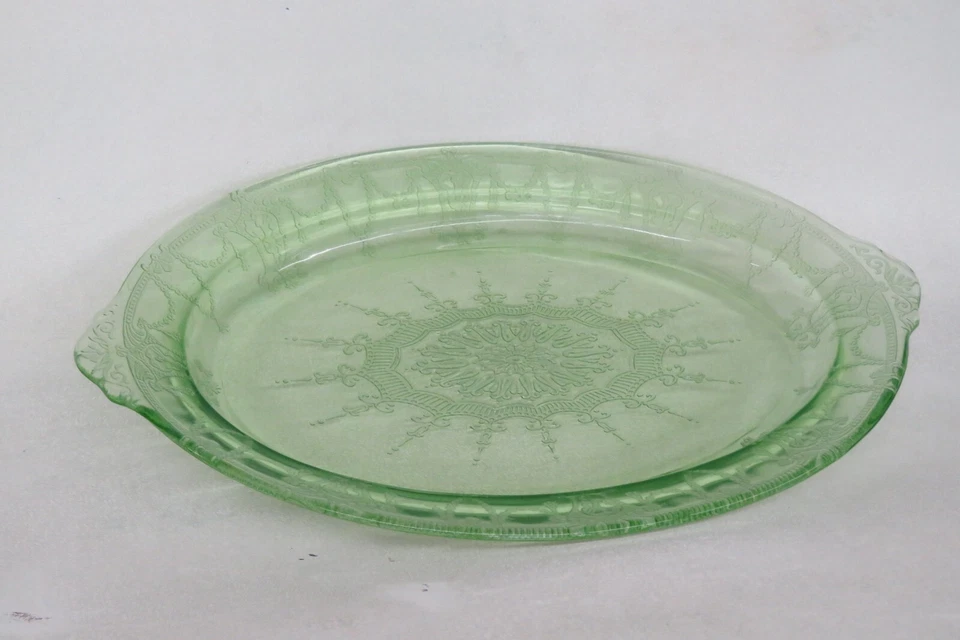
Anchor Hocking’s Cameo Ballerina plate is a standout piece from the 1930s, made from green uranium glass. The plate features a graceful ballerina motif, with a design that captures the elegance of the era. When exposed to UV light, this piece has a faint glow, adding a unique element to its charm. The Cameo Ballerina pattern was only produced for a few years, making it a rare find. The estimated market value of this plate is around $25, with variations based on its condition.
The glow from the uranium glass adds a touch of mystery to this already beautiful plate. It is a sought-after item among collectors, especially those interested in uranium glass. Many collectors appreciate this plate not just for its rarity but also for the way it captures the art deco style. The condition of the plate plays a significant role in its value, with flawless pieces fetching higher prices. This plate is a fantastic representation of the unique glass designs of the 1930s.
Hazel Atlas Royal Lace Green Uranium Glass Bowl
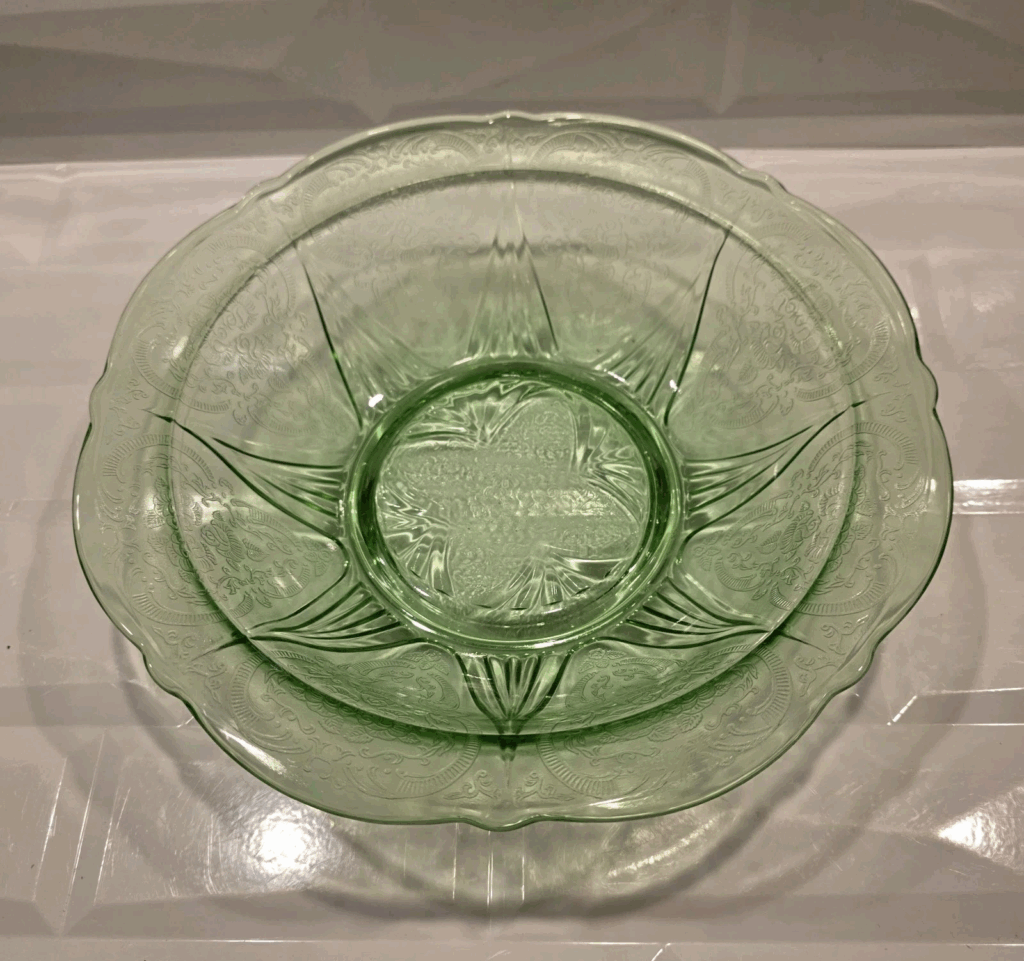
The Hazel Atlas Royal Lace bowl is an iconic piece, known for its intricate lace-like design. Made from uranium glass, it glows under UV light, adding a magical element to its appearance. This bowl was produced during the 1930s and became popular for its elegant design and luminous quality. The Royal Lace pattern is highly collectible, with its distinctive floral border standing out. The estimated market value of this bowl is approximately $18.99.
Collectors are particularly drawn to the glow of uranium glass, which makes this bowl even more desirable. The Royal Lace pattern was one of Hazel Atlas’s signature designs, making it an important part of Depression glass history. The bowl’s rarity and glow make it a prized item in any collection. Its market price is generally determined by its condition, with well-preserved examples commanding a higher value. This bowl is a beautiful example of Depression-era craftsmanship and a must-have for uranium glass enthusiasts.
Fenton Green Depression Glass Vase with Ruffled Rim
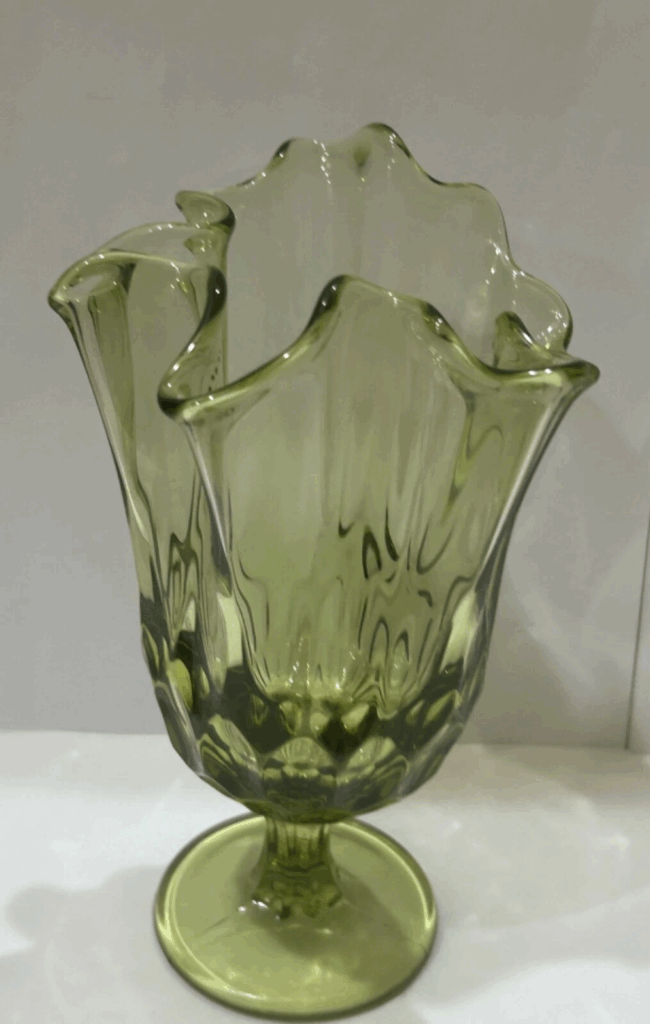
This Fenton green Depression glass vase features a ruffled rim, making it a striking addition to any collection. Produced in the 1930s, it is recognized for its delicate design and graceful shape. The green color is rich and vibrant, showcasing the high-quality glass Fenton was known for. The vase’s ruffled edges add a touch of elegance, making it an eye-catching piece. The estimated value of this vase is around $55, with price variations depending on condition and rarity.
Fenton’s Depression glass vases are prized for their craftsmanship and beauty, and this piece is no exception. The ruffled rim adds a unique touch that sets it apart from other glassware of the era. Collectors appreciate the quality and design of Fenton glass, which has made it a staple in vintage collections. The vase’s market value can increase if it retains its original vibrancy and has no chips or cracks. A well-preserved piece is sure to bring charm and elegance to any vintage glass collection.
Indiana Glass Horseshoe No. 612 Green Etched Plate

This 11-inch plate by Indiana Glass features the Horseshoe No. 612 pattern, which is well-known for its etched design. The green glass adds a vibrant hue to the plate, and the etched pattern gives it a timeless charm. Produced in the 1930s, this plate was part of a larger collection of glassware produced by Indiana Glass. The Horseshoe pattern is sought after by collectors due to its intricate design and relative scarcity. The estimated market value of this plate is around $10.
While this plate may not fetch the highest price, it remains a valuable collectible due to its classic design. The etching on the plate is finely detailed, showcasing the skilled craftsmanship of Indiana Glass. Many collectors seek out pieces from the Horseshoe pattern for their simplicity and elegance. Condition plays a significant role in determining its market price, with flawless pieces being more desirable. This plate is a great entry point for anyone looking to start a collection of Depression glass.
Jeannette Floral Poinsettia Green Uranium Glass Covered Vegetable Bowl

The Jeannette Floral Poinsettia covered vegetable bowl is a stunning example of green uranium glass. Produced during the 1930s, this piece is famous for its floral design and subtle glow under UV light. The pattern is delicate, featuring poinsettia flowers around the bowl’s edges, making it a seasonal favorite among collectors. The bowl’s green color and glowing quality add a unique element to its design. The estimated market value for this piece is around $35.
This vegetable bowl is an excellent representation of the elegance and creativity of 1930s glassware. The glow from the uranium glass makes it stand out, especially when displayed under black light. The Poinsettia pattern is highly sought after during the fall and winter months, adding to its appeal. The market value of this piece can vary based on condition, with well-preserved bowls being more valuable. Its festive design makes it a desirable piece for collectors of vintage glassware.
Hazel Atlas Criss-Cross Green Uranium Glass Reamer Juicer

The Hazel Atlas Criss-Cross green uranium glass reamer juicer is both functional and decorative. This piece features a unique criss-cross pattern and emits a faint glow under UV light, which adds to its charm. Produced in the 1930s, it reflects the era’s focus on both style and utility. The juicer’s green color and intricate design make it a standout item for collectors of Depression glass. The estimated market value for this reamer juicer is approximately $45.
The Criss-Cross pattern is one of Hazel Atlas’s most popular designs, known for its eye-catching texture. The uranium glass adds a special glow, making it a favorite among those who appreciate unique glassware. This juicer is highly collectible, with its functional yet decorative nature making it a desirable piece. As with other Depression glass items, the condition of the piece can influence its market value, with mint-condition examples being more valuable. This reamer juicer combines practicality with vintage charm, making it a great addition to any collection.
Hazel Atlas Eldorado Green Glass Vase
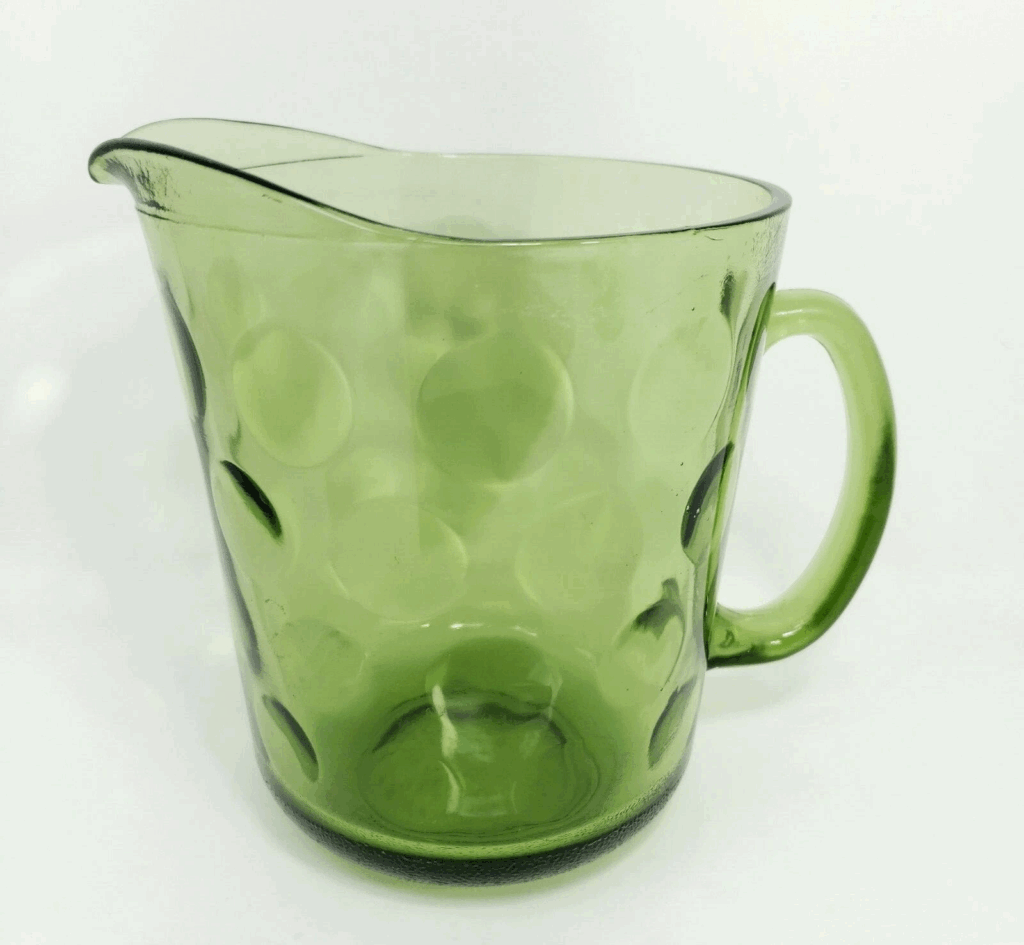
The Hazel Atlas Eldorado green glass vase is known for its bold, floral design, which was produced during the 1930s. The vase is made from a vibrant green glass that showcases the period’s fascination with elegant, decorative items. Eldorado pieces are especially valued for their intricate patterns and craftsmanship. The vase’s unique shape and the detailed design on the surface make it a sought-after collectible. The estimated market value of this vase is approximately $19.95.
This vase is a beautiful example of Depression glass, with its rich green color making it a standout in any collection. The floral motif is detailed and adds to the overall charm of the piece. Eldorado glassware is prized for its delicate craftsmanship and its representation of 1930s artistry. As with other Depression glass pieces, the vase’s condition plays a crucial role in determining its value. Whether displayed as a standalone piece or paired with other vintage glass items, this vase adds character to any collection.
Anchor Hocking Spiral Green Uranium Glass Pitcher
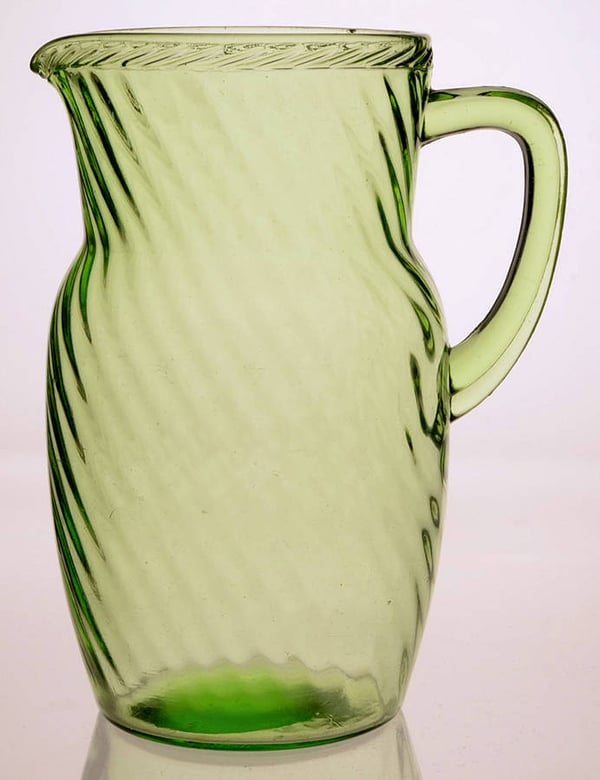
The Anchor Hocking Spiral green uranium glass pitcher is a unique piece from the 1930s that has become a collector’s favorite. The pitcher features the Spiral pattern, which gives it a distinctive, textured appearance. Made from uranium glass, this pitcher glows softly under UV light, making it a captivating item for any vintage glass collector. The estimated market value for this pitcher is around $65, depending on its condition.
The Spiral pattern is a hallmark of Anchor Hocking’s glassware, known for its elegant and timeless design. The pitcher’s green color and glowing quality make it a standout piece in any collection. It was produced during the 1930s, a period marked by the production of some of the most beautiful and functional Depression glassware. Collectors highly value uranium glass pieces, particularly those with unique designs like this pitcher. The pitcher’s value increases with its condition, with flawless pieces being the most desirable.
Jeannette Sunflower Green Uranium Glass Cake Plate

The Jeannette Sunflower cake plate is a rare piece from the 1930s, known for its delicate floral design and luminous glow under black light. Made from green uranium glass, this plate was produced as part of Jeannette’s Sunflower pattern collection. The plate’s intricate design features sunflowers that surround the outer edge, creating a beautiful visual effect. The estimated market value for this cake plate is around $39, with the glow contributing to its appeal.
The Sunflower pattern is one of Jeannette Glass Company’s most sought-after designs, especially among collectors of Depression glass. This cake plate is valued for its elegant appearance and the subtle glow it emits under UV light. Its unique design makes it a prized piece, particularly for those who specialize in uranium glass. As with other Depression glass items, the condition of the plate influences its market price. If you find one in excellent condition, it can make a stunning addition to any vintage glass collection.
Federal Glass Sharon Green Depression Glass Jam Dish

The Federal Glass Sharon jam dish is an example of Depression glass at its finest, showcasing the Sharon pattern’s floral design. Made in the 1930s, this green glass dish is sought after for its timeless beauty and delicate design. The pattern features a floral motif that wraps around the entire dish, giving it an elegant, vintage appeal. The estimated market value of this jam dish is around $50, depending on its condition.
The Sharon pattern by Federal Glass is known for its graceful design, which makes each piece a treasured collectible. The jam dish’s vibrant green color and intricate detailing set it apart from other Depression glass items. Many collectors seek out Sharon glassware because of its beauty and historical significance. The dish’s market value is impacted by its condition, with well-preserved pieces fetching higher prices. This jam dish is a perfect example of the art deco style that defined Depression-era glassware.
This article originally appeared on Avocadu.
